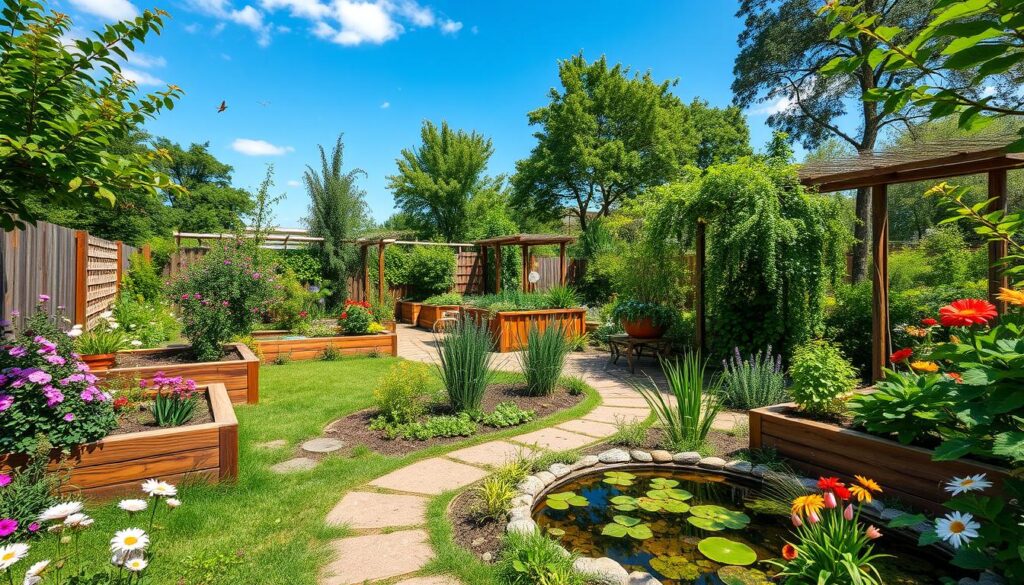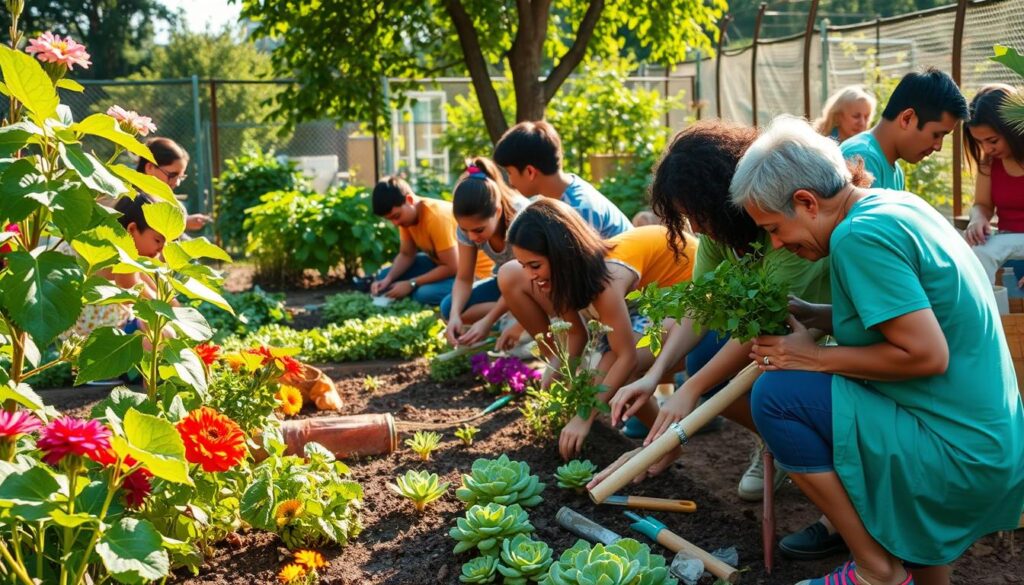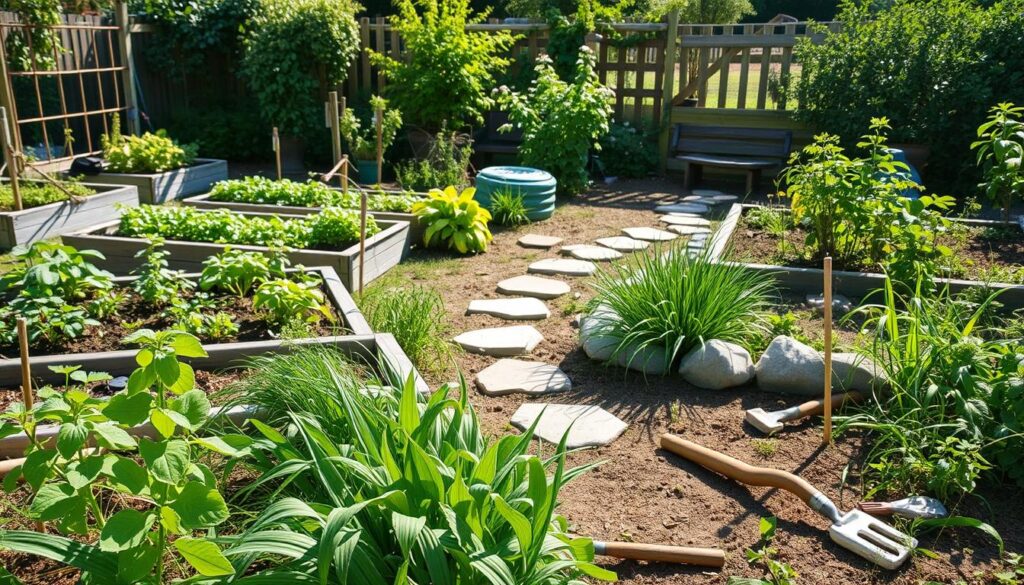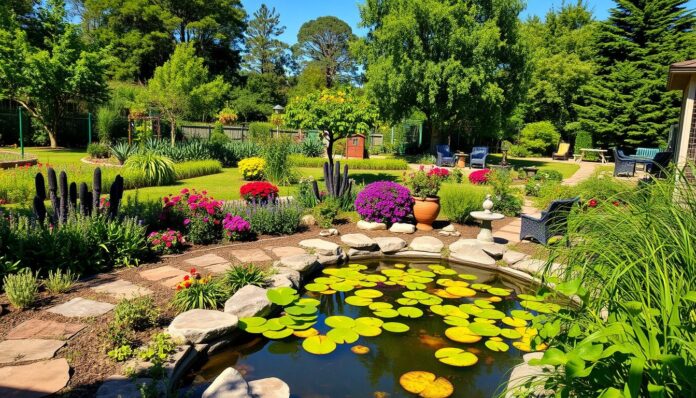In my backyard garden, I found something amazing. Healing comes from the earth itself. Permaculture therapeutic horticulture is more than growing plants. It’s about helping people grow through nature.
Gardening has changed my life. It shows how working with nature can heal our minds. This approach to wellness uses gardening to help people and communities.
Being in nature is good for us. It makes us feel better and helps our bodies. By using permaculture, we make spaces that help people heal and grow.
Key Takeaways
- Permaculture therapeutic horticulture integrates sustainable gardening with mental health support
- Nature connection promotes holistic healing and personal transformation
- Gardens can serve as powerful therapeutic environments
- Ecological mindset enhances individual and community well-being
- Gardening activities can significantly improve mood and cognitive function
Understanding Permaculture and Its Principles
Permaculture is a new way to live sustainably. It changes how we see our environment. It’s about creating landscapes that are both beautiful and productive.
In the 1970s, permaculture started in Australia. It’s a way of farming that lasts forever. The name “permaculture” means “permanent agriculture.”
Definition of Permaculture
Permaculture is a design that copies nature. It makes spaces that work well on their own. It combines nature with human needs.
Key Principles of Permaculture
- Observe and interact with natural systems
- Catch and store energy efficiently
- Obtain sustainable yields
- Apply self-regulation techniques
- Use renewable resources responsibly
Benefits of Permaculture Practices
Permaculture has three main ethics:
- Earth care
- People care
- Fair share of resources
“Permaculture is a design approach that allows us to live in harmony with nature, creating sustainable and resilient ecosystems.” – David Holmgren
| Permaculture Zone | Characteristics | Typical Activities |
|---|---|---|
| Zone 1 | Most frequented area | Kitchen herb gardens, compost |
| Zone 2 | Daily maintenance | Vegetable gardens, cold frames |
| Zone 5 | Wilderness observation | Learning from natural processes |
By following permaculture, we can live better and help the planet. It teaches us to care for nature and ourselves. It’s about learning from the earth.
The Role of Horticulture in Therapeutic Settings
Therapeutic horticulture is a powerful way to improve well-being. It combines nature’s healing power with gardening. This approach turns gardening into a therapy that helps both mind and body.
Understanding Therapeutic Horticulture
Permaculture therapeutic horticulture uses gardening to heal and grow. It’s more than just gardening. It’s about creating experiences that help people grow and find mindfulness.
“Gardens are not just places of growth, but spaces of profound personal transformation.”
Key Benefits of Therapeutic Horticulture
- Reduces stress and anxiety
- Improves motor skills and physical coordination
- Enhances cognitive function
- Promotes social interaction
- Supports emotional regulation
Applications in Different Environments
| Environment | Therapeutic Focus |
|---|---|
| Hospitals | Recovery and rehabilitation |
| Rehabilitation Centers | Physical and mental skill development |
| Community Gardens | Social connection and skill building |
| Schools | Learning and personal growth |
Therapeutic horticulture has been recognized for over 200 years. It helps people with various health issues. Studies show it can lessen mental health symptoms and boost overall wellness.
Mindfulness cultivation through gardening offers a unique pathway to healing. It connects people with nature and themselves in deep, transformative ways.
Integrating Permaculture with Therapeutic Horticulture
Permaculture mental resilience is a strong way to heal and grow through landscape design. It mixes nature’s rules with therapy to make spaces that help both our minds and the planet.

Therapeutic horticulture with permaculture offers special ways to heal our emotions and minds. These systems are more than just gardens. They are complete environments that help us heal and grow.
Synergistic Relationships in Healing Spaces
Gardens designed with care help people grow and connect. Permaculture’s principles make spaces that:
- Help with mental health
- Engage our senses
- Bring people together
- Teach us to live sustainably
Designing Spaces for Healing
Therapeutic gardens use many elements to support healing. Important design points include:
| Design Element | Therapeutic Impact |
|---|---|
| Sensory Plant Selection | Helps with emotional balance |
| Accessible Pathways | Boosts physical and mental health |
| Collaborative Spaces | Builds social bonds |
Case Studies of Successful Integrations
Studies show the good effects of horticulture therapy. A 2012 Journal of Health Psychology study found that being in nature makes us happier. People in these programs feel less stressed, sleep better, and are generally happier.
Nature is not a place to visit. It is home. – Gary Snyder
By using permaculture, we can build healing spaces. These spaces help us and our communities grow through green, caring landscapes.
Psychological Benefits of Therapeutic Horticulture
Therapeutic horticulture is a deep way to connect with nature and improve well-being. It’s not just about growing plants. It’s a powerful tool for healing the mind and growing as a person.
Gardening has amazing benefits for mental health. It helps with mindfulness and reduces stress. Studies show many benefits:
- Decreased depression rates
- Enhanced memory retention
- Improved self-esteem
- Increased happiness levels
Connection to Nature
Gardening connects us deeply with nature. It triggers important brain responses. Studies show that touching soil can boost serotonin, helping fight depression. Research shows gardening can lower anxiety and improve brain health.
Stress Reduction Techniques
Gardening is a special way to manage stress. Activities like planting and harvesting are calming. They help us deal with mental challenges.
The joy of harvesting boosts dopamine, making us feel happy and fulfilled.
Enhancing Mental Health Through Gardening
“Gardening is cheaper than therapy, and you get tomatoes.” – Unknown
Group gardening boosts mental health even more. It helps us connect and feel supported. Regular gardening therapy can lower depression, improve thinking, and build mental strength.
Physical Health Benefits of Horticulture
Permaculture therapeutic horticulture is a great way to boost physical health through gardening. It’s more than a hobby; it’s a way to live sustainably and improve well-being.

Gardening is a fantastic form of exercise that’s good for everyone. Studies show it has many benefits for people of all ages:
- Burns up to 330 calories per hour for a 154-pound individual
- Improves cardiovascular health
- Enhances muscle strength and flexibility
- Reduces risk of chronic diseases
Promoting Physical Activity Through Gardening
Permaculture practices are a natural way to stay fit. A 2023 study found that gardeners were 60% less likely to die over 10 years.
“Gardening is not just about growing plants, but growing health and well-being” – Holistic Wellness Expert
Nutritional Benefits of Homegrown Produce
Growing your own food is key to holistic well-being. It gives you fresh, nutritious food that supports health and sustainable living.
Therapeutic Landscapes for Rehabilitation
Gardens are great for healing. Studies show they can help people recover faster, reduce stress, and improve physical function.
By adding permaculture therapeutic horticulture to your life, you can change how you view health. It helps you connect with nature and supports your physical health.
The Importance of Biodiversity in Therapy Gardens
Therapy gardens are more than just pretty places. They are living worlds that show us how to heal through nature. They use regenerative practices and connect us deeply with the earth.
Biodiversity turns therapy gardens into lively, healing spots. These gardens are full of life, helping both people and the planet.
Role of Native Plants
Native plants are key to strong garden ecosystems. They offer many benefits:
- They need less water and care
- They help local animals thrive
- They make the soil better naturally
- They keep the garden balanced
Creating Diverse Ecosystems
Building diverse ecosystems needs careful planning. Important steps include:
- Choosing many plant types
- Adding things like birdhouses
- Using smart water management
- Practicing organic gardening
Benefits of Pollinator-Friendly Gardens
Pollinator-friendly gardens have big benefits. Studies show they can:
- Lower stress by up to 30%
- Reduce cortisol levels a lot
- Boost mood by 40%
- Help people connect more by 25%
“A biodiverse garden is a living pharmacy of healing and hope.”
By focusing on biodiversity, therapy gardens become powerful for our health and the planet. They show us how deeply connected we are to nature.
Community Engagement Through Horticulture
Therapeutic horticulture is a powerful tool for building strong communities and empowering individuals. Gardens are more than places to grow plants. They become lively spots where people come together, learn, and grow as a group.

Building Connections and Support Networks
Community gardens are key to sustainable living. They unite people from all walks of life, creating a space for real connections. Here, people learn new things, form bonds, and find a common goal.
- Create shared green spaces
- Develop interpersonal relationships
- Promote social inclusion
- Enhance community understanding
Group Activities and Workshops
Structured horticultural programs offer many ways to get involved. From planting seeds to designing gardens, these activities promote teamwork and personal growth. People learn gardening skills and develop important life abilities.
| Activity Type | Skills Developed | Community Impact |
|---|---|---|
| Seed Starting Workshop | Botanical Knowledge | Environmental Awareness |
| Herb Garden Design | Creative Planning | Collaborative Learning |
| Harvest Cooking Class | Nutritional Education | Sustainable Food Practices |
Volunteer Opportunities in Horticultural Therapy
Volunteer programs offer a chance for personal growth and community service. By joining therapeutic gardening efforts, people gain hands-on experience. They also support mental health and the environment.
“Gardens are not just about growing plants, but growing people and communities.” – Aaron Vander Meer
Volunteering in horticultural therapy lets people make a real difference in their community. It’s a chance to grow personally and connect with others.
Educational Aspects of Therapeutic Horticulture
Therapeutic horticulture is a special way to learn about nature and grow as individuals. It offers hands-on learning that helps people understand sustainable living. Students gain important skills and knowledge through these experiences.
https://www.youtube.com/watch?v=mgJECzM9Vng&pp=ygUKI3NvY2FsaG9ydA%3D%3D
Teaching Sustainable Practices
Therapeutic horticulture teaches students about sustainable gardening. They learn practical skills that go beyond school. This connects them with nature in a real way.
- Understanding native plant ecosystems
- Implementing water conservation methods
- Creating biodiverse garden environments
- Developing organic cultivation techniques
Lessons in Responsibility and Care
Gardening teaches students about responsibility. By caring for plants, they learn valuable life lessons. These lessons help them become better stewards of the environment.
“Gardening is an act of hope and a lesson in patience and care.” – Unknown
Programs in Schools and Community Centers
New programs in schools and community centers focus on therapeutic horticulture. They offer learning experiences that promote sustainable living and personal growth. These programs are changing lives across the country.
| Program Location | Focus Area | Key Benefit |
|---|---|---|
| North Carolina Botanical Garden | Therapeutic Horticulture Certificate | Professional Development |
| Anchor Center, Denver | Sensory Garden Education | Skill Development |
| Mental Health Center of Denver | Community Gardening | Personal Empowerment |
These programs show how therapeutic horticulture brings together nature, personal growth, and community. They are a powerful way to learn and grow.
Challenges in Implementing Therapeutic Horticulture
Starting therapeutic horticulture programs is tough. It tests how strong a community is and its commitment to living sustainably. Groups face many hurdles, like not enough money, environmental issues, and wrong ideas about nature therapy.

Resource Limitations
Starting these programs often hits roadblocks. Money, space, and people with the right skills are hard to find. Groups need to think outside the box to make the most of what they have.
- Seek alternative funding sources
- Develop volunteer training programs
- Utilize shared community spaces
- Create partnerships with local institutions
Climate and Environmental Factors
What the local environment is like matters a lot. A green mindset means being flexible and adapting to the local weather, soil, and plants.
| Environmental Challenge | Potential Solution |
|---|---|
| Limited Growing Season | Greenhouse cultivation |
| Poor Soil Conditions | Raised bed gardening |
| Water Scarcity | Drought-resistant plant selection |
Overcoming Public Perception
Changing how people see therapeutic horticulture is crucial. Sharing science, success stories, and real benefits can win over the community.
“Nature itself is the best physician” – Hippocrates
By tackling these challenges head-on, therapeutic horticulture can link people, communities, and nature. It promotes overall health and personal growth.
Training and Certification for Practitioners
Professional development in therapeutic horticulture is a journey of growth. It helps individuals find empowerment through nature and sustainable practices. There are many educational paths that mix science with practical gardening skills.
The field of therapeutic horticulture is full of opportunities for growth. Those starting out can pick from various programs. These programs teach about nature-based healing and supporting communities.
Educational Programs Available
- Certificate programs in horticultural therapy
- University-level degree tracks
- Professional workshops and intensive training
- Online and in-person learning opportunities
Certifications in Horticultural Therapy
Getting certified shows dedication to the field. It means practitioners meet high standards. Here are some key certifications:
| Certification Type | Requirements | Duration |
|---|---|---|
| Registered Horticultural Therapist | Minimum 1 year professional experience | Ongoing professional development |
| Advanced Practitioner Credential | Additional specialized training | Comprehensive examination |
Importance of Professional Development
Staying updated is key in therapeutic horticulture. Practitioners need to know the latest methods and research. This supports personal growth and caring for the environment.
Professional growth is not just about acquiring skills, but transforming perspectives toward regenerative practices.
By always learning, practitioners gain deeper insights. They learn how gardens and green spaces heal. This leads to more impactful therapy for people and communities.
Tools and Techniques in Permaculture Gardening
Permaculture gardening is all about living sustainably. It uses new tools and practices to make gardening a healing activity. By thinking like the earth, gardeners can make spaces that help both people and nature.
Essential Tools for Therapeutic Horticulture
Choosing the right tools is key for gardening success. Today, gardeners have special tools made for different needs. These tools make gardening a better experience for everyone.
- Ergonomic hand tools with adaptive grips
- Raised garden beds for accessibility
- Lightweight implements for reduced physical strain
Techniques for Effective Gardening
Regenerative practices aim to make gardens that are good for the earth and people. They help gardens grow strong and healthy.
| Technique | Benefits | Cost Range |
|---|---|---|
| Hügelkultur Bed Creation | Improves Soil Structure | $0-$50 |
| Intensive Planting | Reduces Pest Problems | $10-$30 |
| Rain Barrel Installation | Water Conservation | $50-$100 |
Innovations in Sustainable Practices
Modern permaculture combines new tech and old wisdom. It makes gardens strong and green. Chaos gardening and solar gardening are new ways to farm sustainably.
“Gardening is not just about growing plants, but cultivating hope and healing.” – Permaculture Expert
- 100% solar-powered gardening facilities
- Self-watering planters that reduce water consumption
- Design principles that mimic natural ecosystems
Case Studies: Successful Therapeutic Horticulture Programs
Therapeutic horticulture is changing lives in many places. It shows how permaculture therapeutic horticulture can help people heal. These programs are making a big difference.
Hospitals and Rehabilitation Centers: Healing Through Gardens
Wilmot Botanical Gardens started a special program in Fall 2016. It helps cancer survivors. The program uses nature to support those dealing with anxiety and depression.
- Weekly sessions for cancer patients and their families
- Utilizing specialized soilless potting techniques
- Focusing on sensory stimulation and stress reduction
Community Gardens and Urban Initiatives: Cultivating Resilience
Community gardens are helping people grow stronger. They offer:
- Plant propagation skills
- Shared gardening experiences
- Building connections through nature
Schools and Educational Programs: Growing Minds
Horticulture therapy adapts to diverse participants. It changes lives for students with different needs. Goals include:
- Improving cognitive abilities
- Enhancing social skills
- Promoting emotional well-being
Nature has the power to heal, connect, and transform lives through intentional therapeutic engagement.
Research and Evidence Supporting Therapeutic Horticulture
Studies have shown the deep impact of therapeutic horticulture on our well-being. They reveal how nature affects our mental health. This research offers new insights into how permaculture helps our mental resilience.
Mental Health Research Findings
Research has found amazing links between gardening and our mental health. Scientists have found that:
- Contact with soil bacteria can increase serotonin levels
- Being in nature reduces stress hormones
- Gardening can trigger positive brain responses
“The healing power of nature is not just a metaphor, but a scientifically proven phenomenon” – Environmental Psychology Research Group
Physical Wellness Discoveries
Nature’s benefits go beyond our minds, offering physical advantages too. Studies show that gardening can:
- Make us fitter through active gardening
- Improve our diet with fresh produce
- Strengthen our immune system
Behavioral and Emotional Outcomes
Gardening can change how we feel emotionally. Research shows that nature can:
- Lessen anxiety and depression
- Boost our brain function
- Make us emotionally stronger
The field of therapeutic horticulture is growing. It shows the power of nature in healing us. This highlights nature’s key role in our overall health.
Policy and Advocacy for Therapeutic Horticulture
Therapeutic horticulture needs strong policies and advocacy. About 61.5 million Americans face mental health issues each year. This makes it crucial to find new ways to help.
Supportive policies can boost community resilience. They see the value of horticultural therapy in helping with mental health and disabilities.
Advocacy groups are key in promoting sustainable living through horticulture. The Canadian Horticultural Therapy Association shows how professionals can make a difference. They work hard to start programs in different communities, focusing on those who need it most.
Personal empowerment is a big win from good horticulture therapy. With the right programs and funding, people can change their lives. Studies show that early help and new ways to treat can lead to better results, for kids and those with different abilities.
The future of horticulture therapy relies on good policies, funding, and teamwork. As more people learn about it, we can build better places for everyone. These places will support well-being through nature and gardening.

